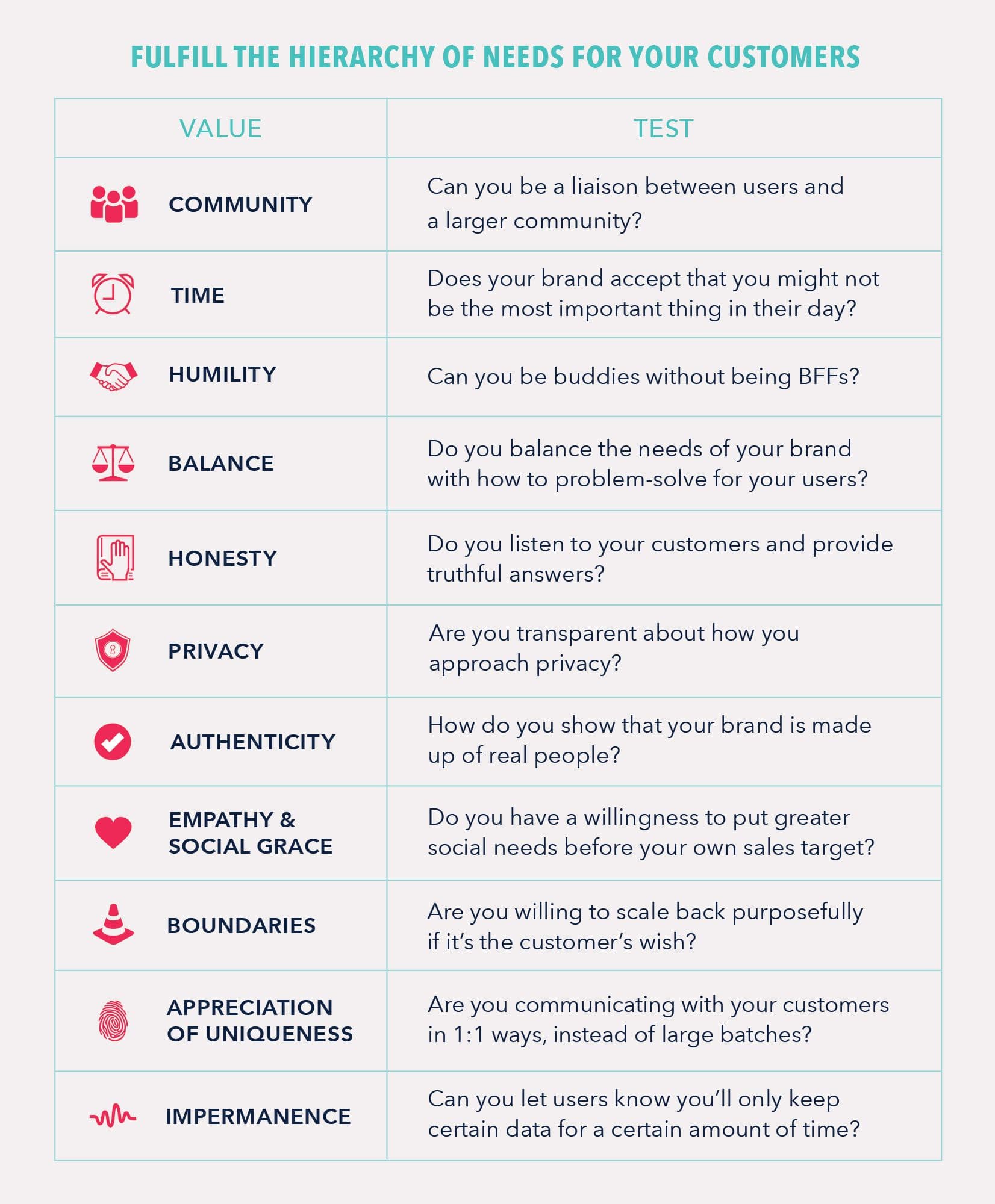What Does It Mean to Build a Relationship With a Digital Audience?
Published on August 09, 2016/Last edited on August 09, 2016/10 min read


Team Braze
“Relationship marketing” is classified, essentially, by two key characteristics: pursuing an ongoing relationship for the long term, and regarding that relationship as a two-way engagement. If your marketing is focused on customer retention and satisfaction, more than it’s focused on getting people to complete a single download or sales transaction, you’re already doing it, at least to some degree. In the world of digital marketing, relationship marketing is widely considered to be where it’s at.
But what is a relationship, in the context of digital media? We don’t mean the sort of digital relationship where you meet the love of your life dressed as a demi-dragon in Second Life. We mean trying to engage your customers, as a marketer, in a sort of mutually beneficial symbiosis.
Do digital marketers build relationships-in-quotes with customers? Or are they real relationships, liberated of irony or subtext? Can it be called a relationship if that relationship costs money to acquire? What does the customer expect from this sort of relationship? What do you? How far are you willing to go—or not go—to put yourself into the customer’s life such that you land, appropriately, in the territory of what most of us reasonably consider to be a relationship?
To unpack some of these questions, we spoke with David Ryan Polgar who self identifies as a Tech Ethicist. In his work, he examines and explores the legal, ethical, and emotional ramifications of technology and social media. In a recent TEDx Talk, Polgar says, “The internet is being overrun with humans acting like bots.” He posits that on the surface, the bulk of our online needs are transactional or informational, but there’s another layer to what we’re looking for when we open an app or a new tab in a browser, and that layer is emotional.
He looks to everyone’s favorite hierarchy of needs (good old Maslow) to point out that we all have deep, basic needs; and now that our digital lives are so deeply entwined with our offline lives, it follows that we seek to meet those intrinsic needs, to some extent, online.
Below, we’ll explore some of those needs and values, and find their digital counterparts, so you can hold your brand against each one to see how you measure up.
Hold your campaigns up against these real-life relationship values

A desire for community
Community isn’t exactly a groundbreaking concept in the digital world. The web had only been around for a few years before every respected web product or content company had a “community manager” in their organizational chart. As in real life, however, there are only so many communities to which a person/user/customer can belong.
Value: community
Hold your brand up to the test: Does your brand create a sense of community? If not, can your brand act as a liaison to usher users into a larger community around your area of interest?
A need to prioritize high value relationships
As with participating in communities, we can only maintain a certain number of relationships at one time. A friend recently recounted a story of a colleague, someone she genuinely liked, who continuously asked her to see a movie or grab a drink on a Friday night. Her issue was time. “I barely get to see the people I already love,” she explained, “and she wants me to see a movie with her?” The same priorities apply to how users interact with brands. What can reasonably be expected of us, and how we divide our time between brand interactions?
Value: time
Hold your brand up to the test: Does your brand know where it stands in the lives of its users? Can you use that expectation to be the most valuable option in your space? Perhaps more time spent on engagement, re-engagement, and retention will make more sense than time spent in pursuit of endless acquisition.
A mutual sense of understanding
We have friends who call us once in awhile, and we have friends who call us all the time. If that once in awhile friend started calling every day, the friendship might end. It’d be way too much. It would come off as arrogant and unaware.
The same goes for brands. Just because someone buys something once doesn’t mean they want to do brunch every Saturday in perpetuity. We’re mixing metaphors there, but you get the picture.
Value: humility
Hold your brand up to the test: Can you be buddies without being BFFs? Can you accept that some users want to be associated with your brand, but they don’t necessarily want you to collect and use all of their preferences and habits? Can you give your users options about how intense your relationship becomes so they don’t feel put upon?
A desire for reciprocity
Relationships are built on a certain level of give and take, and this balance takes time and effort. In most relationships, there are periods where one party needs more—more love, compassion, attention—and the other party gives more. Over time though, in healthy relationships, needs balance out, and each party ends up giving and receiving in a harmony that makes the relationship work.
Value: balance
Hold your brand up to the test: Do you give and take in equal measure? Do you have an awareness of what giving means, and what taking means, in the context of your communications? Are your marketing actions pointed toward getting the most out of your customer? Or do you balance the needs of your brand with real considerations about how to delight, inspire, please, enrich, and problem-solve for your users?
A desire to trust
One of my favorite stats to share is from a 2014 study that showed the quality customers most value is honesty. We’re a cynical lot, and we have a deep and inherent desire to trust. We trust people who prove themselves trustworthy, and even that can be a tall order, interpersonally speaking. If you want folks to trust your brand, you have to behave in trustworthy ways.
Value: honesty
Hold your brand up to the test: Can your customers and users trust that how you represent your product or service is true to who you are as a company? Do you listen to your customers and incorporate their feedback into how you engage?
A reasonable expectation of privacy
A few years ago Mark Zuckerberg declared that privacy is dead, and everyone balked, but we still use all the features of Facebook to which he referred when he made that ominous statement. It should be noted that Mr. Privacy is Dead is said to have purchased all the houses around his primary residence in order to create a bit more privacy for himself and his family.
And what of privacy in your life? Nosy neighbors, prodding PTA moms, an in-law who asks too many questions…. We all have our limits and our thresholds, and this follows to how we engage on the web. We’re willing to give up certain aspects of privacy (sure, Google Maps, follow me everywhere I go), but not too much (please don’t chase that Staryu into the washroom while I’m in here).
Value: privacy
Hold your brand up to the test: Have you fostered transparency with your customers? Have you asked them, outright, where their limits are about how you gather, use, and share their data?
A desire for authenticity
Ah, authenticity. It’s become a marketing buzzword, but it’s still a real achievable thing. In life, authentic people are genuine, engaged. They’re good listeners. They have curiosity in spades, and they don’t fake it. They figure out where they belong, and settle in naturally, without struggle.
Value: authenticity
Hold your brand up to the test: How do you show that your brand is made up of real people? How can you seem like more than a finely hewn algorithm? Can you showcase an understanding of real human traits, like aging, for example, and being impacted by the world around you?
A desire for context and social sensitivity
There’s a range among people that runs from a complete lack of social grace all the way to having highly empathic tendencies, in tune with everything. While we all fall in different spots on that scale, most of us are drawn to people who have more social sensitivity than not. It follows that people will be drawn to brands that can, for example, ride a pop cultural moment with grace. You don’t want to be the brand laughing at a funeral.
Values: empathy and social grace
Hold your brand up to the test: Do you have the self-awareness and willingness to put a campaign on hold if it flies in the face of something happening in the zeitgeist? Do you likewise have a willingness to put greater social needs before your own sales target?
A desire for boundaries
“There’s a fine line between love and stalking,” observes Polgar. “You want your partner to know how you like your coffee, but not what you’re doing every second of the day.” It’s the same with brands. You like it when their omnipresence adds value (ooh, timely coupon!), but not if it goes too far. And “too far” is relative, variable, and highly personal. Geo-targeting, for example, can be great, but it can also affirm our most Orwellian fears.
Value: boundaries
Hold your brand up to the test: Have you communicated with your customers about their preferences around not only privacy, but also intensity of communication, tracking, and outreach? Are you willing to scale back purposefully if it’s the customer’s wish?
A desire to feel unique
“We grow up with a feeling that we’re supposed to be unique,” says Polgar. Part of what we go after in relationships are partners and friends who make us feel somehow special. Brands are able to segment and batch us into groups, and that can create the feeling that we’re not unique at all. “If brands push this too hard, they could trigger the feeling that the consumer is unimportant.”
Value: appreciation of uniqueness
Hold your brand up to the test: Are you communicating to your users in large batches, or in ways that make them perceive their own status as “users who have made one purchase within the last 6 months >$100?”
A willingness to forget
Should the internet remember everything? One of the things that makes growing old with people great is that sooner or later, they’ll forget most of the stupid stuff you once did. Or, at least they’ll act as if they did. The internet, on the other hand, holds onto everything. One way to connect with users could be to communicate your willingness to forget.
Value: impermanence
Hold your brand up to the test: Do we need to store everything? Can you let users know you’ll delete their information every now and again? That, in an effort to be au courant and sensitive to their needs, you’ll only keep certain data for a certain amount of time?
Don’t fear subtlety
Marketing can’t always be about being bigger, louder, more visible; especially since everyone is trying to figure out how to be bigger, louder, more visible. Sometimes, the best marketing is a game of being smarter, calmer, more attuned to the customer’s state of mind.
The more the customer feels listened to, and met, the more empowered—and the less bombarded—they’re likely to feel. When we feel met, and seen, it begins to feel like… you guessed it, like we’re in a relationship.
Be Absolutely Engaging.™
Sign up for regular updates from Braze.
Related Content
View the Blog
A day in the life of a data scientist on the BrazeAIᵀᴹ forward-deployed engineering team

McKay Jensen

The new inbox reality: How iOS changes are reshaping email marketing

Aparna Prasad

Experience optimization: Turning data insights into better journeys
